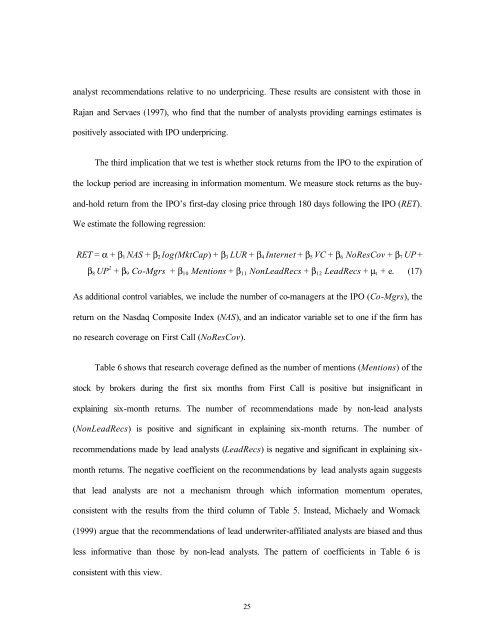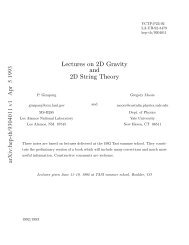Strategic IPO underpricing, information momentum, and lockup ...
Strategic IPO underpricing, information momentum, and lockup ...
Strategic IPO underpricing, information momentum, and lockup ...
Create successful ePaper yourself
Turn your PDF publications into a flip-book with our unique Google optimized e-Paper software.
analyst recommendations relative to no <strong>underpricing</strong>. These results are consistent with those in<br />
Rajan <strong>and</strong> Servaes (1997), who find that the number of analysts providing earnings estimates is<br />
positively associated with <strong>IPO</strong> <strong>underpricing</strong>.<br />
The third implication that we test is whether stock returns from the <strong>IPO</strong> to the expiration of<br />
the <strong>lockup</strong> period are increasing in <strong>information</strong> <strong>momentum</strong>. We measure stock returns as the buy<strong>and</strong>-hold<br />
return from the <strong>IPO</strong>’s first-day closing price through 180 days following the <strong>IPO</strong> (RET).<br />
We estimate the following regression:<br />
RET = α + β 1 NAS + β 2 log(MktCap) + β 3 LUR + β 4 Internet + β 5 VC + β 6 NoResCov + β 7 UP +<br />
β 8 UP 2 + β 9 Co-Mgrs + β 10 Mentions + β 11 NonLeadRecs + β 12 LeadRecs + µ t + e. (17)<br />
As additional control variables, we include the number of co-managers at the <strong>IPO</strong> (Co-Mgrs), the<br />
return on the Nasdaq Composite Index (NAS), <strong>and</strong> an indicator variable set to one if the firm has<br />
no research coverage on First Call (NoResCov).<br />
Table 6 shows that research coverage defined as the number of mentions (Mentions) of the<br />
stock by brokers during the first six months from First Call is positive but insignificant in<br />
explaining six-month returns. The number of recommendations made by non-lead analysts<br />
(NonLeadRecs) is positive <strong>and</strong> significant in explaining six-month returns. The number of<br />
recommendations made by lead analysts (LeadRecs) is negative <strong>and</strong> significant in explaining sixmonth<br />
returns. The negative coefficient on the recommendations by lead analysts again suggests<br />
that lead analysts are not a mechanism through which <strong>information</strong> <strong>momentum</strong> operates,<br />
consistent with the results from the third column of Table 5. Instead, Michaely <strong>and</strong> Womack<br />
(1999) argue that the recommendations of lead underwriter-affiliated analysts are biased <strong>and</strong> thus<br />
less informative than those by non-lead analysts. The pattern of coefficients in Table 6 is<br />
consistent with this view.<br />
25

















